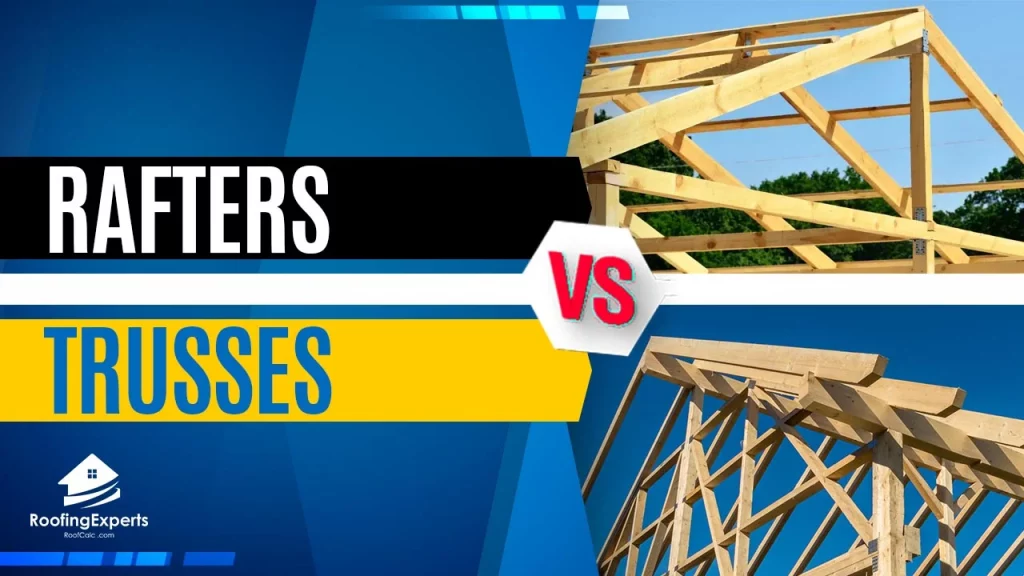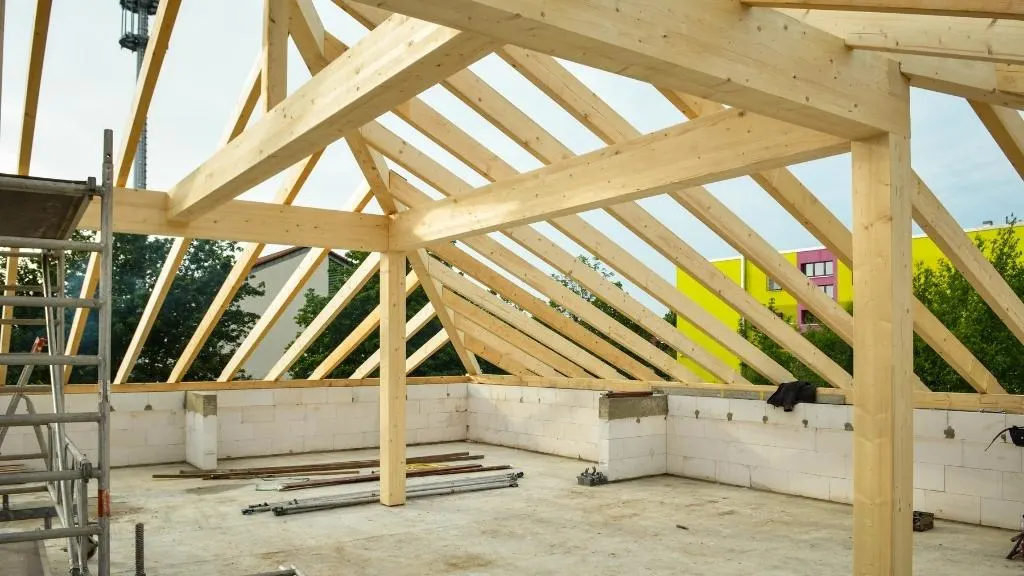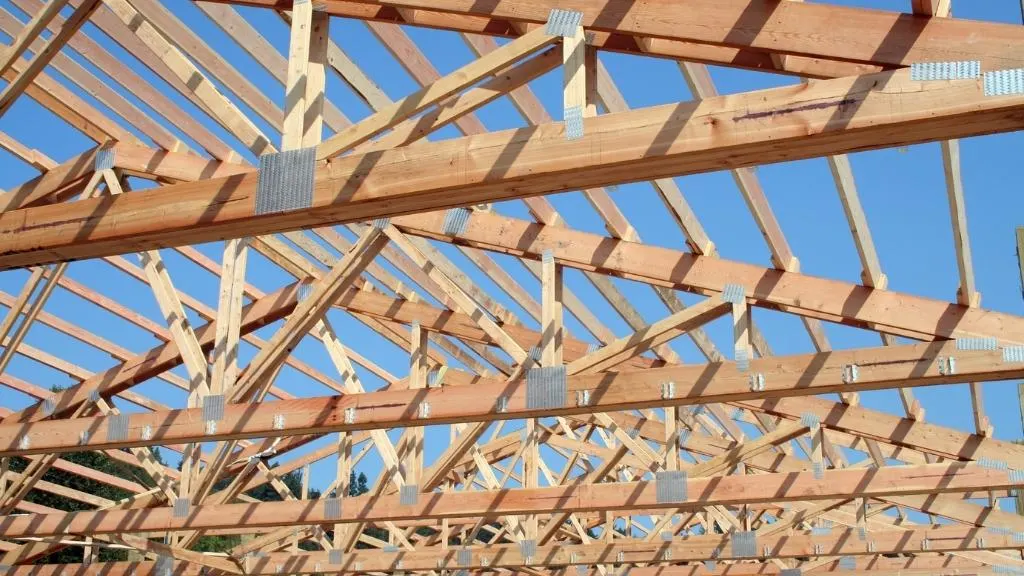
Choosing the right roofing material for your home is an important decision.
It’s not just about aesthetics, it affects how well your roof can stand up to different weather conditions and how economical it will be in the long term.
Trusses are a popular choice as they allow for more headroom and take less time to install than rafters do.
The downside of trusses is that they cannot span as far as rafters so you may need multiple overlapping trusses which can result in a tripping hazard or other safety issue.
Rafters on the other hand, offer greater flexibility and installation options but require more maintenance over their lifespan due to exposure to water and wind.
Deciding between these two types of roofs, rafters vs trusses depends on what you hope to get out of your roof and how much work you’re willing to put into it.
What are Rafters?
Rafters are the slanted beams that attach to your home’s walls at one end and to the ridge of the roof at the other. They support the weight of your roofing material like tiles or shingles.
Pros of Using Rafters
- Rafters offer more flexibility in your roofing options.
- Since they can be cut to length, rafters can support slopes of different heights and sizes.
- They also require less maintenance than trusses do since the top section of your home’s walls won’t be exposed to weather conditions.
- Rafters can give you more attic space since they have a higher headroom height than trusses.
- Rafters are useful for insulation because you can easily install your insulation materials between your drywall and the rafters itself.
- Rafters require less preparation.
Cons of Using Rafters
- Rafters are susceptible to insect infestations and other types of damage since the top portion of the roof is exposed.
- The strength of your rafters depends on how well it can resist bending, bowing or swaying under the weight of your roofing material.
- Rafters can cost you more money because the wood can be expensive and the cost of labor is quite high.
- Rafters requires more installation time.
- You need a professional to install rafters, but there are fewer craftsmen now than before, since trusses are becoming widely used these days.
Where Are Rafters Used Best?
Rafters should be used in areas that aren’t affected by snowfall or other types of severe weather conditions like hurricanes and earthquakes, but still experience strong winds.
Since rafters are cut to size, they can easily withstand the weight of your rooftop materials.
If you live in an area where there is high humidity, then satin nail your rafters to ensure that they don’t become infested by pests.
They also work best for small homes because you can cut them down into different sizes for your roof and woodwork are more home friendly and thus gives you more space to enjoy your attic’s space.

What are Rafters Ridge Boards?
Rafters ridge boards are the horizontal top section of your house’s roof. It can be made of plywood, oriented strand board (OSB), or planks.
Ridge boards are also called ridge beams which are typically installed at the very center of the roof and are what helps support the rafters at the top of it.
Ridge boards can provide better support for your roof since it’s the last point that the weight hits before reaching your rooftop material.
It also offers a nailing surface and serves as a bonding area if you intend to install metal roofing tiles.
Ridge boards can be a bit pricey. They are difficult to cut so you have to call in a professional if you need it customized.
What are Trusses?
Trusses are prefabricated wood or metal structures that act as the framework to support your roof.
They’re much sturdier than rafters and much easier to install as they come in sections that fit together like a puzzle.
Pros of Trusses
- Trusses are expected to be high quality.
- Trusses can be used as flooring and ceiling supports.
- Trusses take less time to install than rafters do since they come pre-assembled and you only need a few pieces to finish the job.
- You can use trusses for insulation as well, just like you can with rafters.
- Trusses offer you a flatter and smoother surface suitable for your roofing options.
- Trusses come in different sizes and thicknesses.
Cons of Trusses
- Trusses look industrial and lack the aesthetic appeal compared to rafters which can result in lower property value.
- Since trusses are prefabricated, that means they’re mass produced which can result in lower quality compared to custom-made rafters.
- Trusses may not be suitable for very steep roofs.
- Trusses are more expensive than rafters due to the higher standards of quality and ease of installation.
- Trusses have less space and may not allow you to enjoy or make use of your attic.
- Trusses are less flexible, and again this is because they are pre-fabricated.
Where Are Trusses Used Best?
Trusses are great for areas that experience heavy snowfall or hurricane-grade winds.
Since trusses are prefabricated, they can be mass produced and manufactured quickly even during emergency situations saving lives and property.
They also excel in design since you can customize them into various shapes and sizes to fit your home’s architectural design.
It is best to also use trusses for buildings since they are easier to transport and build. Larger buildings will require lesser wood work, thus trusses are the way to go.

Which is Better? Deciding Between Rafters Vs Trusses
Trusses win out as far as convenience goes, but you need to take into account whether this will be worth it for you.
They’re a great choice for either new builds or renovations, but might not be advisable for small repairs.
Rafters are the cheaper option and often more durable as well. They’re much easier to replace when they do need replacement due to their modular design so you won’t need an entire roof replacement job.
But you must also consider the costs of maintenance over the lifespan of your roof. In the long run, trusses might be more cost-effective.
You should also take into account your roofing options and their aesthetic appeal. For example, if you want a steep roof with lots of space for attic storage, rafters are probably a better option for you.
Other considerations include whether you’re willing to pay for a professional to install your roofing option, and whether you trust yourself or hire workers to install it.
You should also check if there are any building codes that restrict the use of either rafters or trusses.
As with many other things in life, both options have their own pros and cons which you must weigh up carefully before deciding which is best for you.
Viewing them in isolation can be deceptive, so evaluating both sides of the argument before you come to your decision should ensure that it’s an informed choice.
Why Are Roof Framing Important?
The roof is the most vulnerable part of your entire house.
No matter how many times you fix the interior or exterior up, as soon as a weak spot in your roof is exposed it will start to crumble and decay at a faster rate than the rest of the structure.
This means that regular inspection and maintenance are extremely important to keep not only your roof in good shape but the whole building.
Before you install any roof, it is very important to decide on which type of roof framing system you will be using.
Roofing options like trusses and rafters serve specific purposes, so knowing their differences before starting your project can save your time and money.
As we have discussed above, both rafters and trusses have their own pros and cons, anyhow both will serve your needs.
The most important point here is that your roof should have a very sturdy support which is installed in quality and in a proper way. If you are not sure about your choice, better seek help from professionals!

